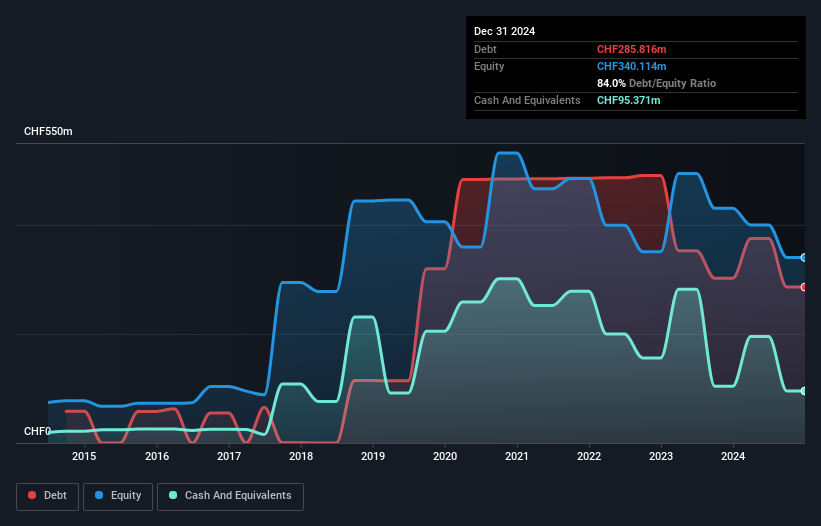Some say volatility, rather than debt, is the best way to think about risk as an investor, but Warren Buffett famously said that 'Volatility is far from synonymous with risk.' It's only natural to consider a company's balance sheet when you examine how risky it is, since debt is often involved when a business collapses. We note that DocMorris AG (VTX:DOCM) does have debt on its balance sheet. But the more important question is: how much risk is that debt creating?
Why Does Debt Bring Risk?
Debt is a tool to help businesses grow, but if a business is incapable of paying off its lenders, then it exists at their mercy. If things get really bad, the lenders can take control of the business. However, a more usual (but still expensive) situation is where a company must dilute shareholders at a cheap share price simply to get debt under control. Having said that, the most common situation is where a company manages its debt reasonably well - and to its own advantage. When we examine debt levels, we first consider both cash and debt levels, together.
What Is DocMorris's Net Debt?
As you can see below, DocMorris had CHF285.8m of debt at December 2024, down from CHF302.1m a year prior. However, because it has a cash reserve of CHF95.4m, its net debt is less, at about CHF190.4m.

How Strong Is DocMorris' Balance Sheet?
Zooming in on the latest balance sheet data, we can see that DocMorris had liabilities of CHF116.5m due within 12 months and liabilities of CHF321.5m due beyond that. On the other hand, it had cash of CHF95.4m and CHF76.9m worth of receivables due within a year. So it has liabilities totalling CHF265.7m more than its cash and near-term receivables, combined.
Given this deficit is actually higher than the company's market capitalization of CHF228.3m, we think shareholders really should watch DocMorris's debt levels, like a parent watching their child ride a bike for the first time. Hypothetically, extremely heavy dilution would be required if the company were forced to pay down its liabilities by raising capital at the current share price. When analysing debt levels, the balance sheet is the obvious place to start. But ultimately the future profitability of the business will decide if DocMorris can strengthen its balance sheet over time. So if you want to see what the professionals think, you might find this free report on analyst profit forecasts to be interesting.
See our latest analysis for DocMorris
Over 12 months, DocMorris reported revenue of CHF1.0b, which is a gain of 4.9%, although it did not report any earnings before interest and tax. That rate of growth is a bit slow for our taste, but it takes all types to make a world.
Caveat Emptor
Over the last twelve months DocMorris produced an earnings before interest and tax (EBIT) loss. Its EBIT loss was a whopping CHF103m. When we look at that alongside the significant liabilities, we're not particularly confident about the company. We'd want to see some strong near-term improvements before getting too interested in the stock. Not least because it had negative free cash flow of CHF55m over the last twelve months. So suffice it to say we consider the stock to be risky. The balance sheet is clearly the area to focus on when you are analysing debt. But ultimately, every company can contain risks that exist outside of the balance sheet. We've identified 2 warning signs with DocMorris (at least 1 which is significant) , and understanding them should be part of your investment process.
At the end of the day, it's often better to focus on companies that are free from net debt. You can access our special list of such companies (all with a track record of profit growth). It's free.
New: Manage All Your Stock Portfolios in One Place
We've created the ultimate portfolio companion for stock investors, and it's free.
• Connect an unlimited number of Portfolios and see your total in one currency
• Be alerted to new Warning Signs or Risks via email or mobile
• Track the Fair Value of your stocks
Have feedback on this article? Concerned about the content? Get in touch with us directly. Alternatively, email editorial-team (at) simplywallst.com.
This article by Simply Wall St is general in nature. We provide commentary based on historical data and analyst forecasts only using an unbiased methodology and our articles are not intended to be financial advice. It does not constitute a recommendation to buy or sell any stock, and does not take account of your objectives, or your financial situation. We aim to bring you long-term focused analysis driven by fundamental data. Note that our analysis may not factor in the latest price-sensitive company announcements or qualitative material. Simply Wall St has no position in any stocks mentioned.
About SWX:DOCM
DocMorris
Operates e-commerce pharmacies and a wholesale business for medical and pharmaceutical products in Switzerland and internationally.
Flawless balance sheet with low risk.
Similar Companies
Market Insights
Community Narratives




